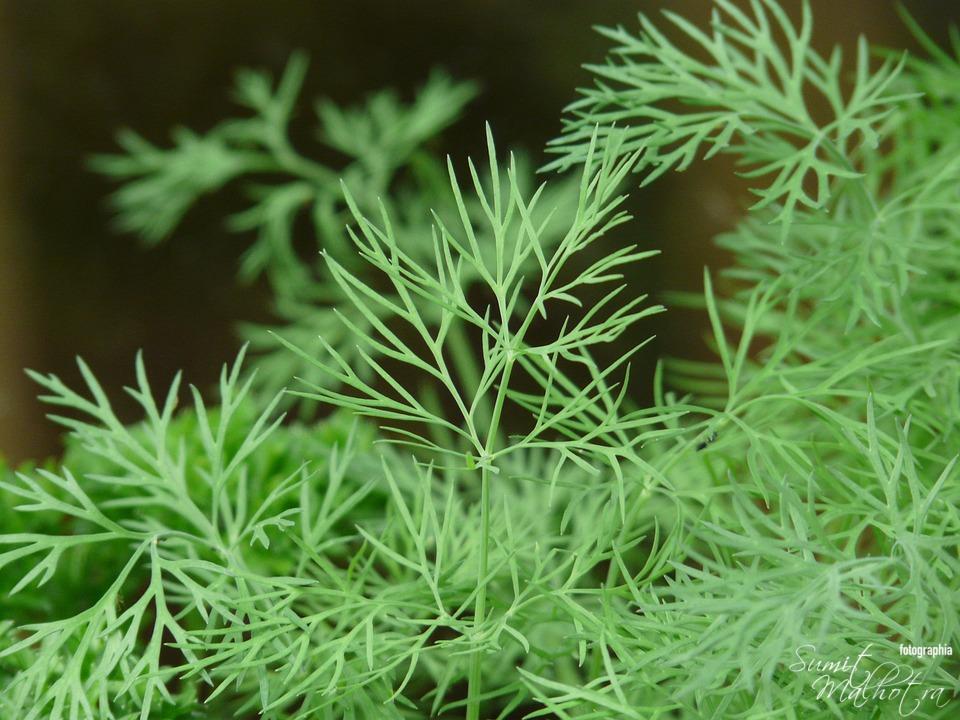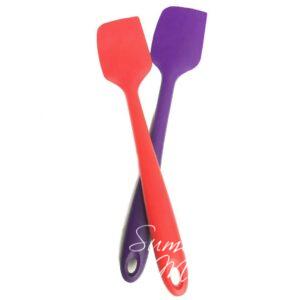All About Dill | Know Your Spice Shatapushpa, Sowa or Soya (Anethum graveolens)
Dill (Anethum graveolens) also known as Dillweed or Shatapushpa, Sowa or Soya is a herbaceous annual with pinnately divided leaves.
The ripe, light brown seeds emit an aromatic odour. The leaves have pleasant aromatic odour and warm taste.
Both the dried fruits (misnamed dill seeds
) and the fresh or dried aerial parts (dillweed
) are used. Fresh dillweed herb is much more aromatic than the dried one.
What are the other names of Dill?
| Indian Languages | Other Languages | |
| Hindi: Sowa or Soya Bengali: Sholpa Gujarati: Suva Malayalam: Sathakuppa Marathi: Shepu Punjabi: Soa Sanskrit: Shatapushpa Tamil: Sataguppi, Guppai Telugu: Soa-Kura, Vakataraha | Latin (Botanical): Anethum graveolens Spanish: Abesón, Aneldo, Eneldo French: Fenouil bâtard German: Gurken Kraut Swedish: Dill Arabic: Shabath, Shibitt Dutch: Dille Italian: Aneto Chinese: Sih loh |
What exactly is Dill?
Dill (Anethum graveolens) is an annual herb in the Apiaceae (Celery family). It is the only species in the genus Anethum.
Dillweed is grown widely in Eurasia, where its leaves and seeds are used as a herb or spice for flavouring food.
Dillweed grows up to 40–60 cm (16–24 in), with slender hollow stems and alternate, finely divided, softly delicate leaves 10–20 cm (4–8 in) long.
The ultimate leaf divisions are 1–2 mm (0.04–0.08 in) broad, slightly broader than the similar leaves of fennel, which are threadlike, less than 1 mm (0.04 in) broad, but harder in texture.
The flowers are white to yellow, in small umbels 2–9 cm (0.8–3.5 in) diameter.
The seeds are 4–5 mm (0.16–0.20 in) long and 1 mm (0.04 in) thick, and straight to slightly curved with a longitudinally ridged surface.
Fresh and dried leaves (sometimes called “dill weed” or “dillweed” to distinguish it from dill seed) are widely used as herbs in Europe and central Asia.
What is the nutritional value of Dill?
It possess great amounts of phytonutrients such as niacin, fiber, copper, phosphorus, vitamin B6, riboflavin, potassium and magnesium which is beneficial to maintain overall health.
Dillweed has Vitamin C (8.44%), Iron (7.38%), Manganese (4.87%), Vitamin A (4.86%), Vitamin B9 (3.25%)
It also contains flavonoids such as vicenin, kaempferol, anethofuran, limonene and monoterpenes carvone.
What is the chemical composition of Dill?
The seeds contain 2.6–4% volatile oil, 40–60% of which is carvone.
Additional constituents are dihydrocarvone, d-limonene, α-phellandrene, α-pinene, and dipentene.
Rich in antioxidants and a good source of vitamin C, magnesium, and vitamin A, dillweed may have several benefits for health, including protection against heart disease and cancer.
What is the history of Dill?
Dillweed originated in southern Russia, the Mediterranean, and Western Africa. It has been used as a medicinal herb for at least 5,000 years.
It is referred to in the Bible in Matthew by its original Greek name Anethum, and was used in the Middle Ages by magicians against witchcraft.
The name is derived from the old Norse word dilla, meaning to lull or soothe, referring to the carminative properties.
In addition to the magical powers attributed to the herb in ancient times, it was considered a palliative of stomach pains.
The Ancient Egyptians used dillweed as a soothing medicine, and it was also used in aphrodisiacs and to ward off witches. The Greeks used it as a symbol of wealth.
The Romans believed that dillweed brought good fortune. The Romans also used the leaves in the wreaths they made to recognize athletes and heroes.
In ancient times soldiers would apply burnt dill seeds to wounds to help them heal.
Dillweed has been found in the tomb of Egyptian Pharaoh Amenhotep II, dating to around 1400 BC.
It was also later found in the Greek city of Samos, around the 7th century BC, and mentioned in the writings of Theophrastus (371–287 BC).
In 1525 Bankes’ Herbal said that “dill assuageth wicked winds in the womb” (meaning the stomach).
In the 1627 play Nymphidia by Michael Drayton, the herb is mentioned in the following lines:
‘Therewith her Vervain and her Dill,
That hindereth Witches of their Will.’
What are the uses of Dill?
- Dillweed is widely used in food and the food industry in order to flavor foods and beverages.
- Seeds and leaves of the herb are essential for flavoring and seasoning of salads, dips, pickled vegetables, seafood dishes, soups, sour cream, meats, sauces, and cream cheese.
- The food industry uses the essential oil, extracted from both leaves and seeds, in candies, pickles, chewing gums, etc. as flavoring agent.
- Its essential oils have significant antifungal effect during the storage of foods.
- The seeds are a common and very effective household remedy for a wide range of digestive problems.
- Decoction of leaves and seeds are introduced in a carminative, diuretic, and antiemetic formula.
- Pickled seeds with vinegar are prescribed for nausea treatment as a gastro tonic agent.
- The essential oils extracted from the plant are extensively used in perfumery, as perfuming agents and in cosmetics.
- Russian cosmonauts recommend its use in human spaceflight due to the confined quarters and closed air supply for its antiflatulent benefits.
What does Dill taste like?
It has a deliciously fresh, citrus-like taste, with a slightly grassy undertone. It’s trademark subtle sweetness means it works particularly well with garlic and mint.
The herb flavour is reminiscent of caraway or anise.
What are the ayurvedic properties of Dill?
Rasa (taste) – Katu (pungent), Tikta (bitter)
Guna (qualities) – Laghu (light to digest), Teekshna (piercing, enters deep tissues)
Vipaka (taste conversion after digestion): Katu (pungent)
Veerya (potency) – Ushna (hot)
Effect on Tridosha – Balances Vata and Kapha. It increases Pitta.
According to Bhojana Kutuhalam twelfth chapter, The leaves of shatapushpa are hot in potency, sweet in taste, and treat gulma.
It alleviates vata, stimulates digestive fire, wholesome to the body, aggravates pitta dosha and imparts taste.
What can I use Dill for?
Dillweed tends to lose flavor when cooked. Hence, to retain the flavor of this herb, always add it at the end of the cooking process.
- You can use it in a potato salad or over fish.
- The seeds can be used as a spice to flavour foods like pickles or bread.
- It is excellent on cold soups featuring beets, cucumbers, or yogurt.
- Use it for your tzatziki, the traditional Greek cucumber yogurt salad.
- It is also good with spreads, sour cream, cream cheese, and lamb.
- Fresh, finely cut leaves can be used as a topping in soups.
- Fresh leaves can be mixed with sour cream as the basis for a dressing.
- Dillweed sauce can be used hot or cold for hard-boiled eggs.
- You can pair it with chives as a flavoring for potato chips.
How long does Dill last?
Store the dillweed in the vegetable bin of your refrigerator. It should last up to a week and perhaps even longer. Fresh dillweed sprigs can be frozen for up to two months.
How do I store Dill?
To successfully store fresh sprigs, spray whole stems lightly with water, wrap loosely in kitchen (paper) towels, and place in a sealed zip-top plastic bag in a refrigerator.
Is there a substitute for Dill?
Tarragon works wonderfully well as a substitute for dillweed. Replace fresh for fresh and dry for dried in recipes. Some more substitutes are:
- The feathery fronds of fresh fennel can be used to flavour soups, stews & garnish.
- For seeds, you can try explore seeds as an alternative. They also have a strong aroma and taste akin to anise seeds, which is similar to dill.
- You can use thyme as well to flavour many of the same times of dishes for which dillweed would be used.
Where do I buy Dill from?
Dried dillweed and seeds can be found in the spice section of the grocery store. Look for bunches of fresh dillweed in the produce or fresh herb section.
It is also available online via Amazon & other portals.
What are the health benefits of Dill?
The following are health benefits of Shatapushpa, Sowa or Soya.
- Health Benefits of Shatapushpa as an Antioxidant – Antioxidants are naturally occurring compounds that help protect cells against damage caused by unstable molecules known as free radicals.
- Health Benefits of Dill for Heart Health – Flavonoids, like those found in dillweed, have been shown to protect heart health due to their potent antioxidant and anti-inflammatory properties.
- Health Benefits of Shatapushpa against Diabetes – Dillweed has been suggested to have blood-sugar-lowering effects.
- Health Benefits of Dill against Cancer – As the herb is high in monoterpenes, particularly d-limonene, it may have anticancer properties.
- Health Benefits of Shatapushpa for Bone Health – The herb contains calcium, magnesium, and phosphorus — all of which are important for bone health
- Health Benefits of Dill for Digestion – The anti-flatulent property of fresh herb sprigs reduces the formation of gas in the alimentary canal, thus reducing bloating, flatulence, and abdominal distension.
- Health Benefits of Shatapushpa against Insomnia – The abundance of flavonoids and B-complex vitamins in the leaves make it a one-stop natural remedy for insomnia.
Note: Sometimes consuming dillweed in excess quantities can show some allergic reactions including diarrhea, vomiting
Tools & Equipment Used For This Recipe
FInally! To Sum It Up
Dill (Anethum graveolens) also known as Sowa or Soya is a herbaceous annual with pinnately divided leaves.
The ripe, light brown seeds emit an aromatic odour. The leaves have pleasant aromatic odour and warm taste.
Both the dried fruits (misnamed dill seeds
) and the fresh or dried aerial parts (dillweed
) are used. Fresh herb is much more aromatic than the dried one.
Rich in antioxidants and a good source of vitamin C, magnesium, and vitamin A, dillweed may have several benefits for health, including protection against heart disease and cancer.
STAY CONNECTED
If you like this article, you can let us know in the comments below or on social media using #gosumitup and tag @gosumitup.
I am always happy to read your feedback and if you liked the dish or if you made the dish. :)
Better still, take a picture and post it on Instagram and tag it as #gosumitup
Connect direct – You can also connect with me directly on my Instagram and Facebook or on Pinterest.
And, keep visiting us for more of such awesomeness. Do bookmark gosumitup.com into your web browser now or simply subscribe to our browser notifications.
This article has been compiled for general information only and should not be used for the diagnosis or treatment of any medical condition/s.
This information is not intended to diagnose, treat, cure, or prevent any disease.
GoSumItUp.com has used all reasonable care in compiling the information but offers no warranty as to its accuracy or its use in any possible form.
Consult a doctor or other health care professional for diagnosis and treatment of any medical condition/s. For more details please refer to our disclosure policy.






2 comments
Great to learn so much about dill and its culinary uses. Thanks.
Thank you Rajaram .. Do follow the All About *Spice* series @ https://gosumitup.com/tag/encyclopedia-of-spices